#The Cattle Raid of Cooley
Explore tagged Tumblr posts
Text
Food on St Patrick's Day (in the USA)...
...is usually Corned Beef & Cabbage, which is the Irish-American version of the original Irish boiled bacon & cabbage, but while the celebratory Irishness is still going strong, try something a bit more authentic.
A nice warm coddle. Not cuddle, coddle, though just as comforting in its own way. (Some sources suggest it's a hangover cure, not that such a thing would ever be necessary at this time of year, oh dear me no.)
Coddle is a stew using potatoes, onions, bacon, sausages, stout-if-desired / stock-if-not, pepper, sage, thyme and Time.
You'll often see it called "Dublin Coddle", but my Mum made Lisburn Coddle lots of times, I've made West Wicklow Coddle more than once, and on one occasion in a Belgian holiday apartment I made Brugsekoddel, which is an OK spelling for something that doesn't exist in any cookbook.
*****
I do remember one amendment I made to Mum's recipe, which met with slight resistance at the time and great appreciation thereafter.
Her coddle was originally cooked on the stove-top, not in the oven, and nothing was pre-cooked. Potatoes were quartered, onions were sliced, bacon was cut into chunks and then everything went into the big iron casserole, then onto the slow back ring, and there it simmered Until Done.
However, the bacon was thick-cut back rashers, and the sausages were pork chipolatas.
Raw, they looked like this:
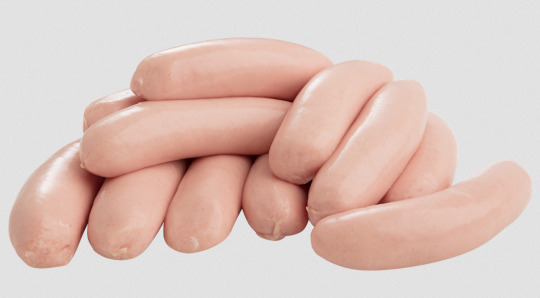
...and the bacon looked like this:

Cooked in the way Mum initially did, they looked pretty much the same afterwards. The sausages didn't change colour. Nor did the bacon.
While everything tasted fine, the meat parts always looked - to me, anyway - somewhat ... less than appealing. "Surgical appliance pink" is the kindest way to put it, and that's all I'm saying. This is apparently "white coddle" and Dubs can get quite defensive about This Is The Way It SHOULD Look.
I'm not a Dub, so I persuaded Mum to fry both the bacon and sausages first, just enough to get a bit of brown on, and wow! Improvement! I remember my Dad nodding in approval but - because he was Wise - not saying anything aloud until Mum gave it the green light as well.
Doing the coddle in the oven, first with lid on then with lid off, came later and met with equal approval. So did using only half of the onion raw and frying the other half lightly golden in the bacon fat.
Nobody quoted from a movie that wouldn't be made for another decade, but there was a definite feeling of...
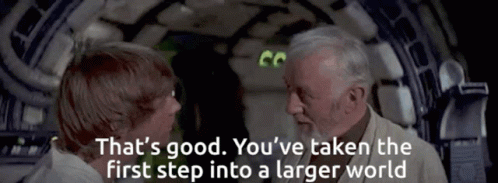
*****
There are coddle recipes all over the Net: I've made sure that these are from Ireland to avoid the corned-beef-not-boiled-bacon "adjustment" versions which are definitely out there. I've already seen one with Bratwurst. Just wait, it'll be chorizo next.
Oh, hell's teeth, I was right. And from RTE...
Returning to relative normality, here's Donal Skehan's white coddle and his browned coddle with barley (I'm going to try that one).
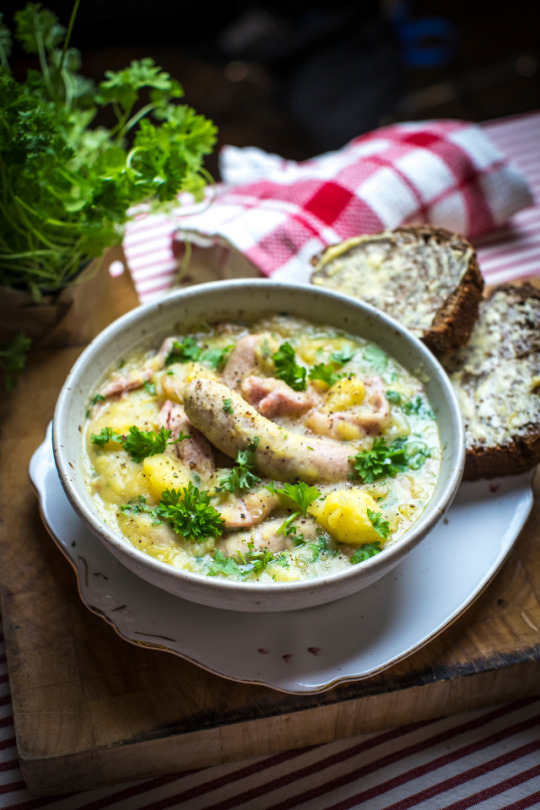

Here's Dairina Allen's Frenchified with US measurements version. (I feel considerably less heretical now.)
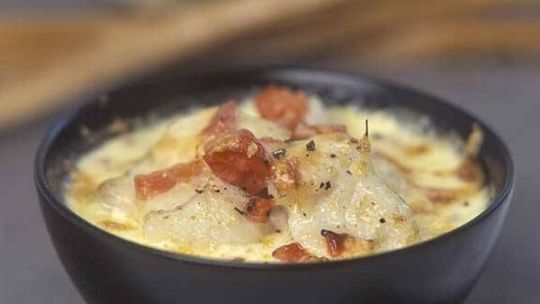
And finally (OK, not Irish, but it references a couple of the previous ones and is a VERY comprehensive write-up, so gets a pass) Felicity Cloake's Perfect Dublin Coddle (perfect according to who, exactly...?) in The Guardian.
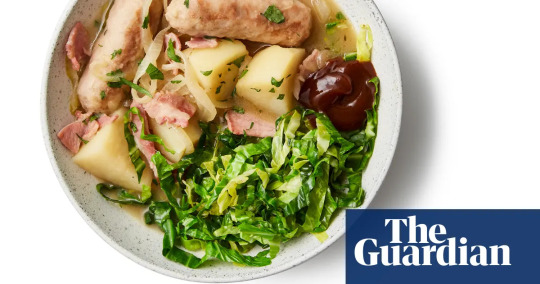
*****
Returning to the beginning, and how boiled bacon became corned beef (a question which prompted @dduane to start an entire website...!)
The traditional Irish meat animal for those who could afford it was the pig, but when Irish immigrants (even before the Great Famine) arrived in the USA, they often lived in the same urban districts as Jewish immigrants from Eastern Europe.
For fairly obvious reasons pork, bacon and other piggy products were unavailable in those districts, but salt beef was right there and far cheaper than any meat Irish immigrants had ever seen before.
Insist on tradition or eat what was easy to find? There'd have been contest - and do I sometimes wonder a bit if sauerkraut ever came close to replacing cabbage for the same reason.
The pre-Famine Irish palate liked sour tastes: a German (?) visitor to Ireland in the mid-1600s wrote about about what were called "the best-favoured peasantry in Europe", and mentioned that they had "seventy-several sour milks and creams*, and the sourer they be, the better they like them."
* Yogurt? Kefir? Skyr? Gosh...
Corned beef and Kraut as the immigrants' celebratory "Irish" meal for St Patrick's Day? Maybe, maybe not.
Time for "Immigrant Song" (with kittens).
youtube
*****
Corned beef got its name from the size of the salt grains with which the beef was prepared. They were usually bigger than kosher salt, like pinhead oats or even as large as grains of wheat, and their name derived originally from "corned (gun)powder", the large coarse grains used in cannon.
BTW, "corn" has been a generic English term for "grain" for centuries, and "but Europe didn't have corn" is an American mistake assuming the word refers to sweetcorn / maize, which it doesn't.
Lindsey Davis, author of the "Falco" series, had a couple of rants about it and other US-requested "corrections". As she points out, mistakes need corrected but "corn" is not a mistake, just a difference in vocabulary.
*****
In Ancient and Medieval Ireland pig would have included wild boar, the hunting of which was a suitable pastime for warriors and heroes, because Mr Boar took a very dim view of the whole proceeding and wasn't shy about showing it (see "wild boar" in my tags and learn more).
Cattle were for milk, butter, cream and little cattle; also wealth, status, and heroic displays in their theft, defence or recovery. It's no accident that THE great Irish epic is "The Cattle-Raid of Cooley" / Táin Bó Cúailnge (tawn / toyn boh cool-nyah).
Killing a cow for meat was ostentation on a level of lighting cigars with 100-, or even 500-, currency-unit notes. Once it had been cooked and eaten there'd be no more milk, butter, cream or little cattle from that source, so eating beef was showing off And Then Some.
Also, loaning a prize bull to run with someone else's heifers was a sign of great friendship or alliance, while refusing it might be an excuse for enmity or even war. IMO that's what Maeve of Connaught intended all along, picking undiplomatic envoys who would get drunk and shoot their mouths off so the loan was refused and she, insulted, would have an excuse to...
But I digress, as usual. Or again. Or still... :->
*****
For the most part, "pig" mean "domestic porker", and in later periods right up to the Famine, these animals were seldom eaten.
Instead, known as "the gentleman who pays the rent", the family pig ate kitchen scraps and rooted about for other foods, none of which the tenant had to grow or buy for them. These fattened pigs would go to market twice a year, and the money from their sale would literally pay that half-year's rent.
For wealthier (less poor?) farmers, pigs had another advantage. Calves arrived singly, lambs might be a pair, but piglets popped out by the dozen. A sow with (some of) her farrow was even commemorated on the old ha'penny coin...

What with bulls, chickens, hares, horses, hounds, pigs, salmon and stags, the pre-decimal Irish coinage is a good inspiration for some sort of fantasy currency.
But that's another post, for another day.
#food and drink#St Patrick's Day#Irish cuisine#Dublin coddle#corned beef or boiled bacon#pigs and cattle in Ireland#The Cattle Raid of Cooley#Youtube
561 notes
·
View notes
Text
I saw this post from someone that was related to the cattle raid of cooley, and i decided to make this

#the cattle raid of cooley#irish mythology#the ulster cycle#estonian mythology#ireland#estonia#ulster#saaremaa#cu chulainn#suur toll#queen medb#vanapagan#meme#mythology
9 notes
·
View notes
Text
youtube
The Tain is an EP by The Decemberists released in 2004 by Acuarela Discos and in 2005 by Kill Rock Stars. The single 18-plus minute track, in five parts, is named after the Irish mythological epic Táin Bó Cúailnge, often simply called The Táin.
The Táin or less commonly as The Cattle Raid of Cooley, is an epic from Irish mythology. It is often called "the Irish Iliad", although like most other early Irish literature, the Táin is written in prosimetrum, i.e. prose with periodic additions of verse composed by the characters. The Táin tells of a war against Ulster by Queen Medb of Connacht and her husband King Ailill, who intend to steal the stud bull Donn Cuailnge.
Video directed by Andy Smetanka
Lyrics:
[part 1]
[Crone]
Here upon this pillow
Made of reed and willow
You're a fickle little twister
Are you sweet on your sister?
Your fallow won't leave you alone
And granted for their pleasure
Possessions laid to measure
She's a salty little pisser
With your cock in her kisser
But now she's a will of her own
[PART II]
[Husband]
Damn your ankles and eyes wide
From you fingernails to your ponytails too
King of the insects and the m-5
Over Charlemagne in a motorcade too
And baby needs a new prize
Baby needs a new and shiny prize
[Captain]
In this place called heavenly
You were born here
This place called heavenly
You were born here
You were born here
[Husband]
And now all the marchers descend from high
I will dedicate all of my awakenings to this
And damn all the angles that oppress my sight
I will bleed your heart through a samovar soon
Baby needs a new prize
Baby needs a new and shiny prize
[Captain]
In this place called heavenly
You were born here
This place called heavenly
You were born here
You were born here
You were born here
[PART III]
[Soldier]
They settled dust in your hair
To watch you shake and shout it out
With our armaments bared
We shed our bags and travel-alls
From the lee of the wall
He comes in the chang and chariot
And all his eunuchs in thrall
Can scarce lift his line and lariat
Here come loose the hounds
To blow me down
[Chorus Of Waifs]
Blow me down
[Soldier]
On this stretch of ground
I'll lay me down
[Chorus Of Waifs]
Lay me down
[Soldier]
To sleep
[Chaplain]
And now stricken with pangs
That tear at our backs like thistle down
The mirror's soft silver tain
Reflects our last and birthing hour
[Soldier]
Here come loose the hounds
To blow me down
[Chorus Of Waifs]
Blow me down
[Soldier]
On this stretch of ground
I'll lay me down
[Chorus Of Waifs]
Lay me down
[Soldier]
Here come loose the hounds
To blow me down
[Chorus Of Waifs]
Blow me down
[Soldier]
On this stretch of ground
I'll lay me down
[Chorus Of Waifs]
Lay me down
[Soldier]
To sleep
[PART IV]
[Widow]
O the wind is blowing, it hurts your skin
As you climb up hillside, forest and fen
Your arms full of lullabies, orchids and wine
Your memories wrapped within paper and twine
The room that you lie in is dusty and hard
Sleeping soft babies on piles of yards
Of gingham, taffeta, cotton and silk
Your dry hungry mouths cry for your mother's milk
When the dawn comes to greet you, you'll rise with clothes on
And advance with the others, singing old songs
Of cattle and maidens and withered old queens
Let the music carry you on
The room that you lie in is dusty and hard
Sleeping soft babies on piles of yards
Of gingham, taffeta, cotton and silk
Your dry hungry mouths cry for your mother's milk
[PART V]
[Woman]
Darling dear what have you done?
Your clothes are torn, your make-up runs
[Daughter]
I ran through brambles, blooming thistle
I washed my face in the river when you whistled me on
[Woman]
Darling dear, what have you done?
Your hands and face are smeared with blood
[Daughter]
The chaplain came and called me out
To beat and to butcher his mother's sow
[Woman]
But darling dear, they found him dead
This morning on the riverbed
But hush now darling, don't you cry
Your reward's in the sweet by-and-by
Hush now baby, don't you cry
Your reward's in the sweet by-and-by
[Crone]
And now we've seen your powers
Softly stretch the hours
You're a fickle little twister
Are you sweet on your sister?
As now you go wandering home
#Youtube#the tain#the decemberists#Colin melody#music#irish mythology#Táin Bó Cúailnge#The Cattle Raid of Cooley#Queen Medb#Cúchulainn#Wycinanki#Wayang#prog rock#indie rock#folk rock#Andy smetanka
9 notes
·
View notes
Text
spent too long straying from my english major roots. now I have to listen to an audio recording of the entire english translation of the táin bó cúailnge. see y'all on the other side
#MEDIEVAL IRISH EPIC SAVE ME. MEDIEVAL IRISH EPIC. SAVE ME MEDIEVAL IRISH EPIC.#táin bó cúailnge#the cattle raid of cooley#english major tag#bs.txt
10 notes
·
View notes
Text
My tag for this series is 'fairy tales'.
#polls#fairy tales#folktales#violet#the empty pot#the white wolf#the monkey people#king thrushbeard#the cattle raid of cooley#táin bó cúailnge#the disobedient daughter who married a skull#the fairy comb#the boy and the golden stars
18 notes
·
View notes
Text
Jet as Cú Chulainn and Zuko as Ferdiad au when
14 notes
·
View notes
Video
youtube
The Tain - The Decemberists
From the lee of the wall He comes in The Chang and The Chariot And all his eunuchs in thrall Can scarce lift his line and lariat.
Here come loose his hounds To blow me down. (Blow me down.)
On this stretch of ground I'll lay me down. (Lay me down.) To sleep.
#The Decemberists#The Tain#Táin Bó Cúailnge#The Cattle Raid of Cooley#Irish Mythology#Music#Shadow Puppets#Shadow Play#Music Video
1 note
·
View note
Text
Sometimes you're cursed because the king a few generations back humiliated a goddess and forced her to race against his horses even while she was on the very cusp of giving birth. Sometimes you're cursed because your father decided it was a fantastic idea to kill, cook and serve you up to your grandad and various distant family members in some twisted attempt at a 'Gotcha!!!' moment, and somehow this has now become your problem. So it goes.
I don't know, Tantalus. Even if you do want to test whether the gods are omniscient, killing your son, cutting him up, boiling him and serving the resulting 'meal' to the gods as part of a banquet to see if they can tell you're sercing them human flesh is a bit.
Much.
#long post#okay now I'm done#tantalus#pelops#greek mythology#Táin Bó Cúailnge#The Cattle Raid of Cooley#irish mythology
325 notes
·
View notes
Text
I really need to draw Achilles as a Wendy’s employee
Achilles: Do you want fries with that. Cù Chulainn: Where I’m from we call fries Potato Jeremy’s!! Achilles: WHERE THE FUCK ARE YOU FROM
#greek mythology#hellenic pagan#mythology and folklore#iliad#pagan#celtic mythology#irish mythology#tawnboculaigne#Cattle raid of cooley#Cu chulainn#setante
23 notes
·
View notes
Text
friend sent me an instagram reel that got me talking about queen maeve/medb and fat asses



11 notes
·
View notes
Text

Studying the greatest epic in Irish mythology
#an táin bó cuailnge#it translates as the cattle raid of cooley#we've always been obsessed with cows
2 notes
·
View notes
Photo
Spoiler. She was killed by cheese
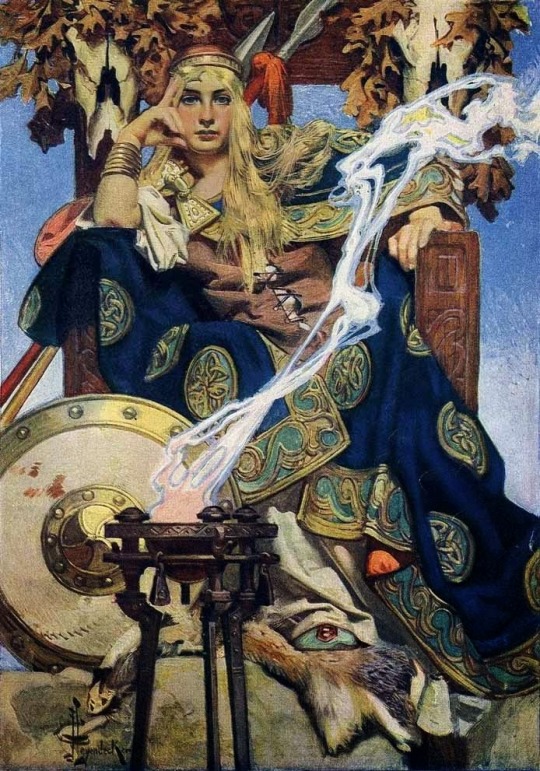
Queen Maeve, from The Century Magazine by J. C. Leyendecker (January 1907)
#j. c. leyendecker#queen maeve#gay artist#meds#méibh#irish mythology#ulster cycle#táin bó cúailnge#cattle raid of Cooley
7K notes
·
View notes
Text
Not to get too intense about it, but I really do love a good retelling, but my criteria for good retellings are... not high, but perhaps more specific than they are for most people. If I had to make a list
A good retelling must understand the original text and its context. If one is retelling a Greek myth, you must understand not only the plot of the myth, but the author should also at least understand the intent behind the myth, both in charitable and uncharitable interpretations.
A good retelling must add something new by telling this story again. You can't just say that this is the same story... but in space! You have to know that the creation of a different context for a story fundamentally creates different themes and understandings, and take advantage of that. To go back to Greek myth, Hadestown is fundamentally a retelling of the story of Orpheus and Eurydice. However, instead of solely focusing on Hades as a figure representing Death, Hadestown focuses on Hades as a patron of the wealthy, the lord of all wealth hidden beneath the earth as much as the bones that also lay there. The story is then reframed as not just the story of Orpheus and Eurydice but also of the story of an early 1900s company town wherein Hades is the exploitative boss. Orpheus is voice of the downtrodden, traveling to this place of the downtrodden and trying, in his own way, to affect some tiny bit of change. In what I'd consider one of the seminal songs in the musical, "If It's True," where his simple action of singing this question about whether this is the only way things have to be awakes the deadened workers and their collective force makes Hades respond.
A good retelling must stand on its own even if the audience is unfamiliar with other tellings. Knowing the original should enhance the experience, but it should not be necessary. Sorry to keep using musical examples, but The Tain by The Decemberists is still a great song with solid lyrics, even if they're abstracted from the original story of The Cattle Raid of Cooley. They change the lyrics to more modern ideas, with references to Charlemagne, cars, and so on, but the through-line of the story is very clearly there. The story even ends with a direct question to Medb - was all that really worth it?
I dunno where I was going with the rest of this, but those are my thoughts on the matter.
7K notes
·
View notes
Note
Why would cu be sexist?
The Cattle Raid of Cooley (Táin Bó Cúailnge):
Cu Chulainn's relationship with his wife Emer. Emer is portrayed as a strong, intelligent, and outspoken woman who challenges Cu Chulainn's actions at times.
The Wooing of Emer:
- Emer as a skilled warrior and poet in her own right, not simply a prize to be won.
because of all this (with the sources i mean), which i posted in the og post where i announced cu as the seventh love interest
not exactly a stellar guy (just like most characters from old myths) but that's why he's so perfect for this lol
23 notes
·
View notes
Text
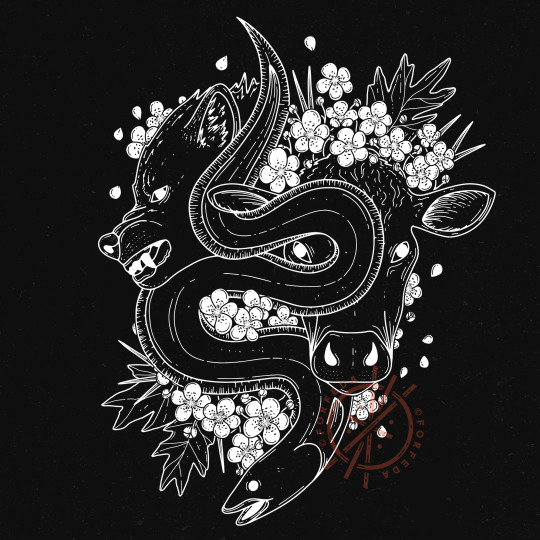
PHANTOM AT THE FORD
"I will come against you in the form of an eel about your feet in the ford, so that you shall fall… I will drive the cattle on the ford to you, in the form of a grey she-wolf… I will come to you in the form of a hornless red heifer before the cattle. They will rush on you on the plains and on the fords, and on the pools, and you will not see me before you…" - The Morrígan to Cú Chulainn, Táin Bó Cúailnge
In the Táin Bó Cúailnge ("the Cattle Raid of Cooley"), the warrior Cú Chulainn is able to stave off the advances of Queen Medb's army by invoking his right to single combat at the fords, singlehandedly defeating each of Medb's champions in turn. But when Cú Chulainn refuses help from the Morrígan, a powerful goddess, she resolves to instead be a hindrance to him, taking different animal forms to disrupt his battles - an eel to trip him, and a wolf and a heifer to drive the cattle over the ford.
This piece depicts the three forms of the Morrígan surrounded by the thorns and flowers of the hawthorn, a tree connected to terror, baneful magic, and the powers of the Otherworld in Gaelic folklore.
#celtic#celticart#mythology#irish mythology#celtic mythology#folklore#morrigan#cu chulainn#shapeshifter#tain bo cuailgne#ulster cycle#hawthorn#deity#gaelpol#pagan#pagan art#goddess#forfedaproject
209 notes
·
View notes
Text
Táin Bó Cúailgne Mosaic | Dublin
Along Dublin’s Nassau Street there is a mosaic mural, created in the 1970s by Belfast artist Desmond Kinney. Táin Bó Cúailnge (the driving-off of cows of Cooley), sometimes rendered The Cattle Raid of Cooley or The Táin is a legendary tale from early Irish literature, often considered an epic, although it is written primarily in prose rather than verse. It tells of a war against Ulster by the…
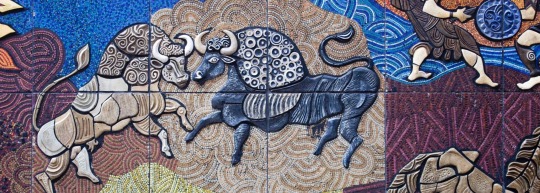
View On WordPress
18 notes
·
View notes